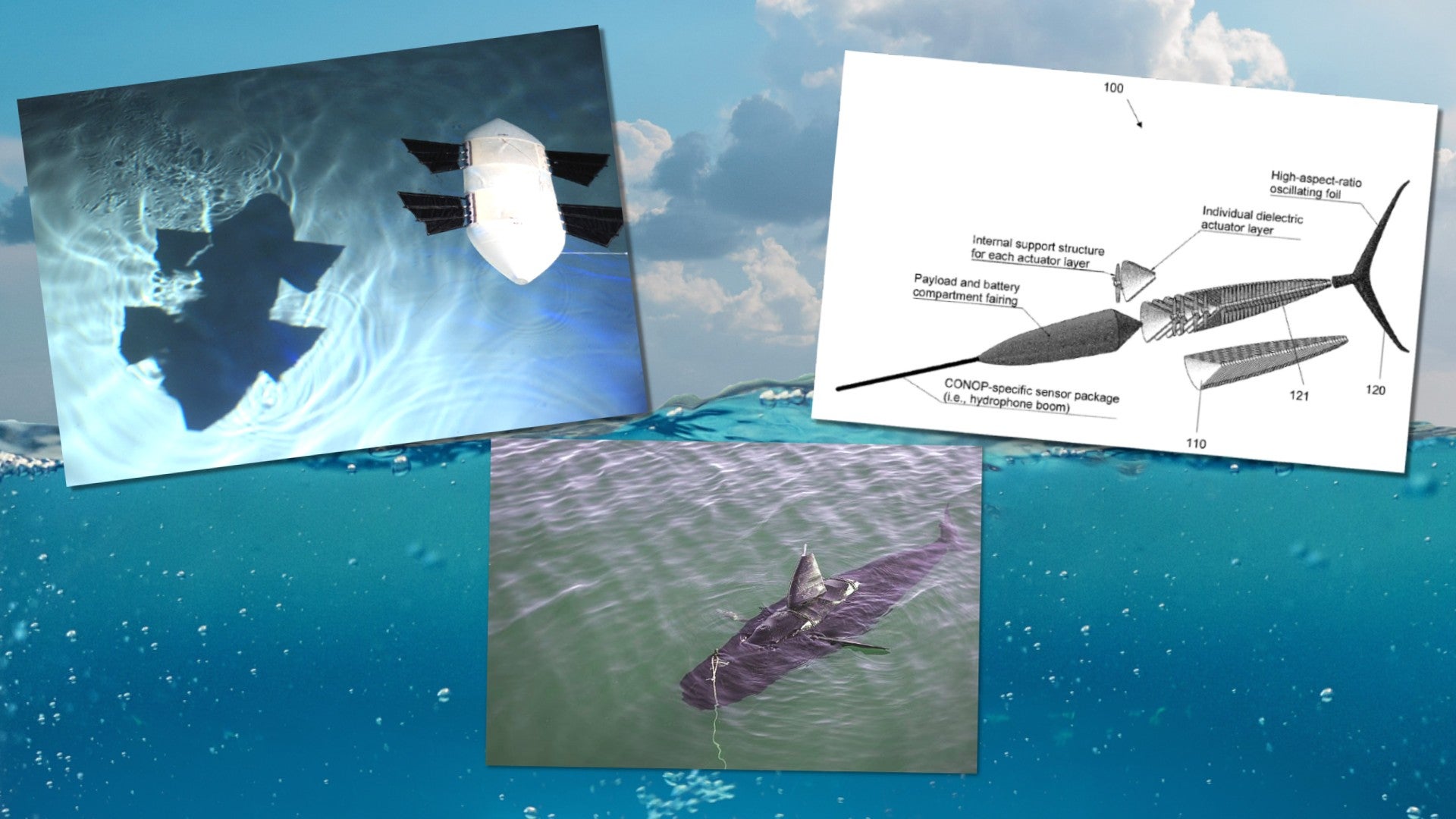The U.S. Navy appears to be taking a cue from mother nature by seeking to develop “bio-inspired autonomous systems” that mimic or leverage characteristics of the natural world to accomplish Navy missions. Specifically, the U.S. Navy’s Fiscal Year 2022 budget requests contain close to $30 million for developing “Biocentric” or “Bio-Inspired” technologies such as unmanned underwater vehicles that can move, school, blend in with their surroundings, and sense their environments in ways similar to the living creatures that inhabit the seas. Most notably, the research outlined in the Navy’s budget documentation includes highly ambitious plans to develop bio-inspired autonomous vehicles that can operate both in air and underwater, and transition seamlessly between the two.
The Navy’s proposed Fiscal Year 2022 Budget, released on May 28, 2021, contains two line items in the Navy’s Research, Development, Test & Evaluation justification book related to the research and development of these systems specifically. Two program elements within the Navy’s budget, Defense Research Sciences and Warfighter Sustainment Applied Research, requested $9.45 million and $15.99 million, respectively, for line items titled “Bio-Inspired Autonomous Systems” and “Bio-Inspired Autonomous Systems and Soft Robotics.”
For FY2022, the Navy’s budget request for Biocentric Technologies, housed within the “Warfighter Sustainment Applied Research” program element, totals $9.45 million. Within that, the “Bio-Inspired Autonomous Systems” line item outlines more specific goals of that request for 2022, including plans to:
– Conduct applied research on bio-inspired underwater vehicle propulsion and control.
– Mature advanced search behaviors for autonomous vehicles.
– Integrate sonar and image processing into a bio-inspired unmanned vehicle to evaluate obstacle detection and avoidance in congested spaces and neutralization maneuvers.
One of the most eyebrow-raising goals for the Navy’s FY2022 investment into this unique class of vehicles is to conduct “applied research on bio-inspired cross-domain vehicles for amphibious and sea/air transitions.” Concepts for submersible aircraft capable of operating in both air and water have been looked into by the Navy in the past, but without the emphasis on bio-inspired designs and unmanned technologies, specifically.
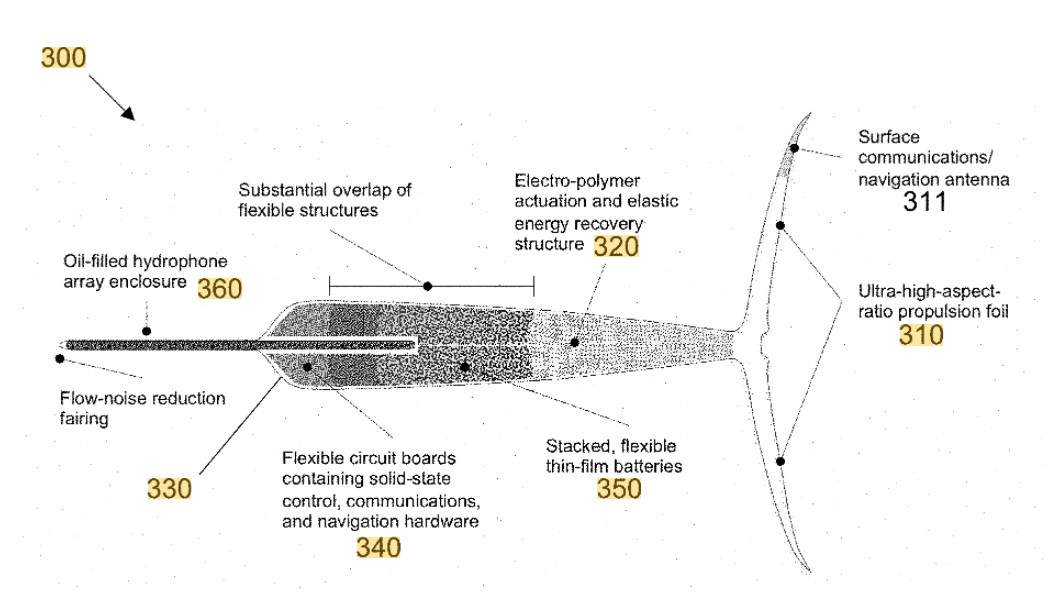
Other plans for the Navy’s Biocentric Technologies research are concerned with materials research, microbial electrochemical systems for waste-to-energy conversion, and sensor development. These include conducting applied research on bio-inspired underwater navigation, control, and “advanced search behaviors.” Some of that work involves integrating sonar systems “into a bio-inspired unmanned vehicle to evaluate obstacle detection and avoidance in congested spaces” and conducting applied research to “develop and evaluate lateral line based intelligent sensing and control.” Lateral lines are a sensory system found in marine vertebrates like fish that enables them to sense movement or vibrations in the water around them, providing spatial awareness.
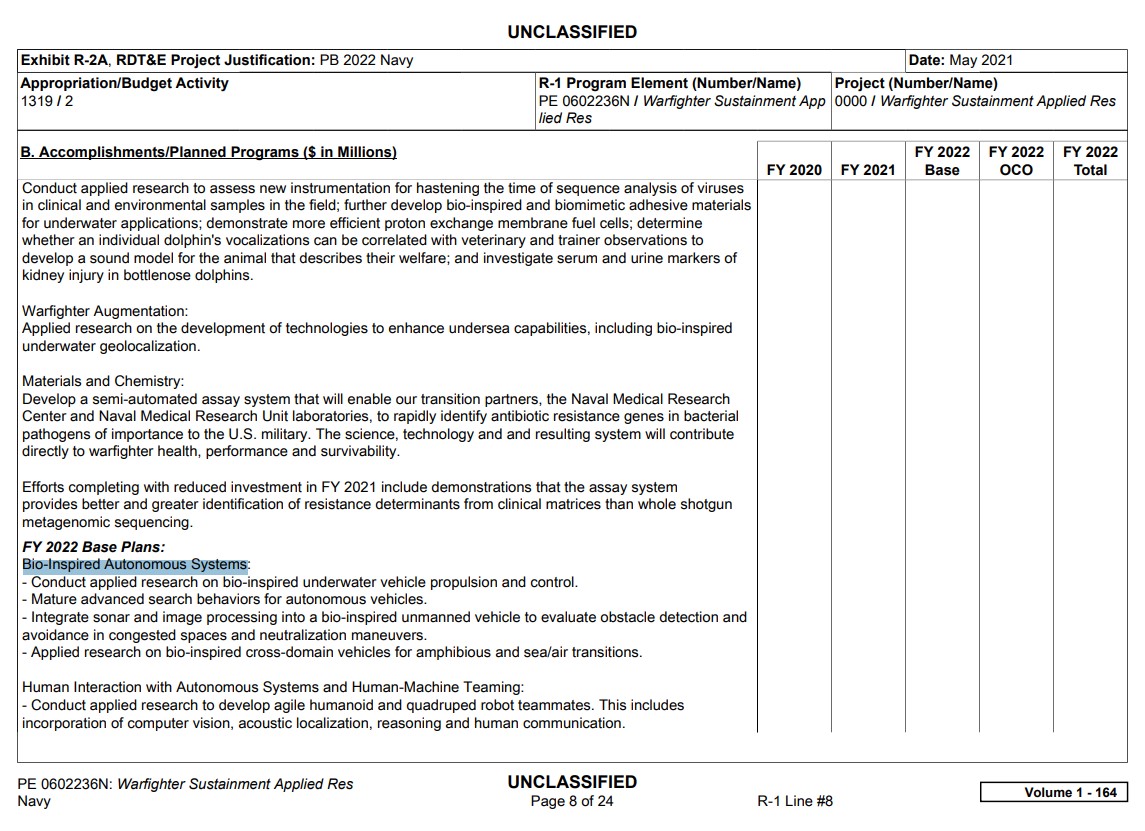
In addition to the elements cited above, the Navy’s Defense Research Sciences program element requested $15.9 million for its Medical and Biological Sciences research for FY2022. That research specifically outlines “research on bio-inspired mechanisms to develop multi-spectral camouflage technologies,” developing “experimental sensing capabilities and modeling for bio-sensing to enable sensorimotor control including fish schooling for passive swarm coordination in underwater vehicles,” and the “exploration of bio-inspired locomotion from amphibious animals to enable technologies for amphibious and cross-domain vehicles.”

In addition, the program includes the “Bio-Inspired Autonomous Systems and Soft Robotics” line item that mentions developing “high-lift, stealthy propulsion without propellers and achieve high maneuverability for underwater vehicles,” among other goals. This sounds a lot like wing-like locomotion as found on birds.
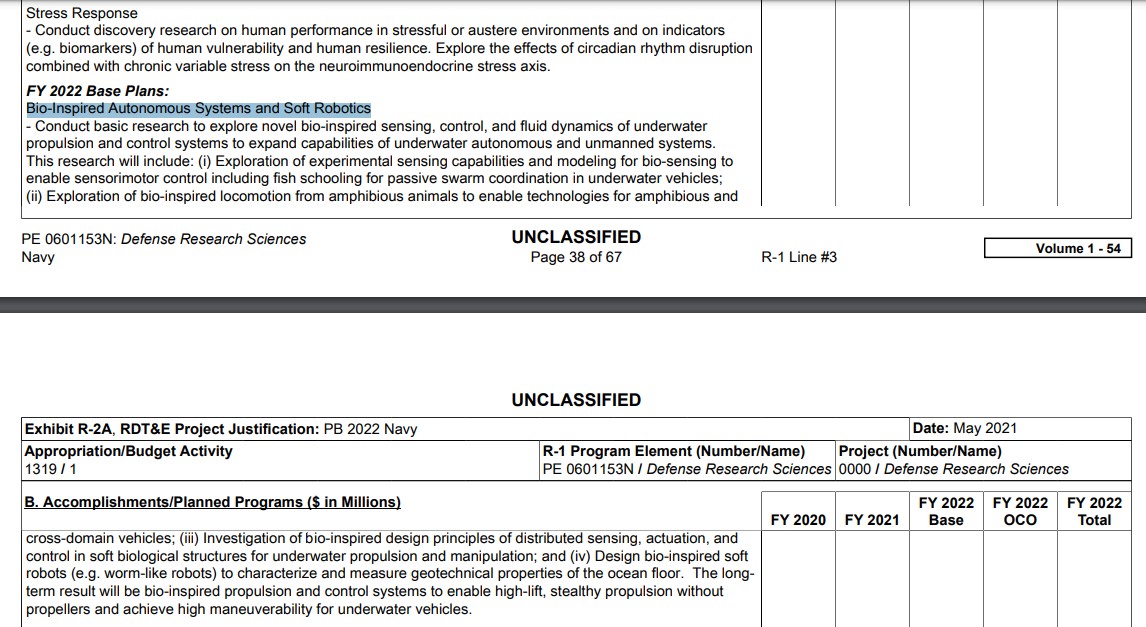
The Navy’s FY2022 budget request also contains a Congressional addition of $3 million for bio-inspired engineering, including soft robotics, modes of animal-like propulsion including “fin-based swimming, flapping flight and legged locomotion,” and nature-inspired sensor systems.

The Office of Naval Research (ONR) describes the scope of their Bio-Inspired Autonomous Systems research on the program’s website, writing that the overall purpose is to “expand the operational envelope” of the U.S. Navy:
The aim of Bio-Inspired Autonomous Systems is to extract principles of sensorimotor control, biomechanics and fluid dynamics of underwater propulsion and control in aquatic and amphibious animals that underlie the agility, stealth, efficiency and sensory adaptations of these animals. The principles that emerge from this interdisciplinary research are formalized and explored in advanced prototypes. The goal of this program is to expand the operational envelope of Navy underwater and amphibious vehicles and enable enhanced underwater manipulation.
A Naval Research and Development Framework document from 2020 mentioned research projects that included such bio-inspired topics as Biologically Inspired Sensors and Autonomous Systems, Novel Autonomous Platforms, Synthetic Biological Sentinel Organisms and Circuit Designs, and more.
Many different bio-inspired designs have been pursued by the DOD and the Navy, specifically, for some time. In 2014, ONR demonstrated its GhostSwimmer project which sought to develop a UUV that propelled itself like a fish and could operate at depths ranging from 10 inches to 300 feet. The GhostSwimmer could reportedly operate in both tethered, with a man in the loop, and independent/autonomous modes:

The Naval Research Laboratory (NRL) has previously looked at developing a UUV shaped like a fish, called WANDA, for chemical signature detection in shallow waters. The NRL has also attempted to develop “bio-inspired cross-domain vehicles” capable of sea/air transitions with the so-called “Flimmer” vehicles which could fly through the air as well as “swim” below the waves:

Hints of the Navy’s more recent bio-inspired ambitions may be able to be seen in patent documentation. In 2018, the U.S. Navy was granted a patent for an “Acoustically stealthy soft-bodied UUV propulsion system,” applied for by an oceanographer at the U.S. Naval Research Laboratory. In images accompanying the patent application, the UUV is depicted much like a swordfish, and the propulsion system is described as having a spine-like “central chord member” in addition to “a series of successive muscle layers each having a skeletal mechanism and a set of actuators.”
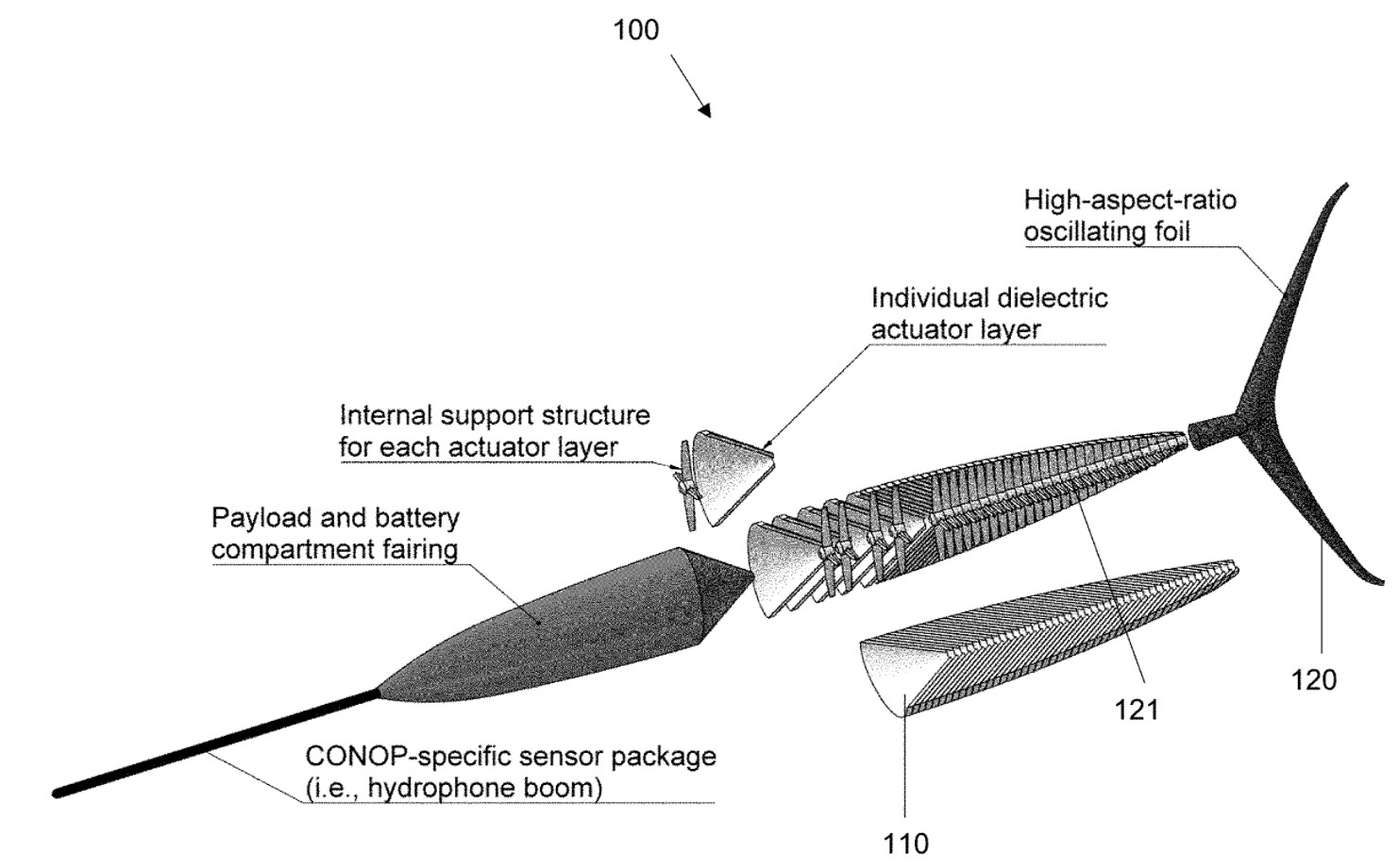
DARPA and ONR have even researched small “underwater walking machines” that resemble lobsters and can crawl along the bottoms of bodies of water.
The bio-inspired “passive swarm coordination in underwater vehicles” research being conducted by the Navy also demonstrates just how central swarming technologies will soon be below the waves in addition to in the skies. “Schools” of small UUVs that behave like schools of fish would represent a revolutionary new capability for clandestine underwater operations, particularly in distributed sensing. While marine animals such as whales and dolphins have been employed to varying degrees of success by naval forces in the past, the Navy’s focus on blending nature with technology represents a new way to leverage the natural world for use in military operations.
This Bio-Inspired Autonomous Systems research demonstrates the Navy’s increasing focus on developing unmanned underwater systems designed to be more difficult to observe by the growing underwater sensor networks in contested waters. Such systems could be aimed at deployment in areas such as the Arctic and the South China Sea, which have become flashpoints for territorial disputes, naval power projection competition, and general geopolitical friction. Deploying UUVs that better blend in with marine life could be a way to emplace sensors and other systems without attracting too much attention. After all, the underwater sensors of today are far more sophisticated than in years past, meaning engineers have to work that much harder to develop vehicles that can slip past enemy sensor networks undetected.
Bio-inspired designs that could be mistaken for the real thing could offer a way of reducing the potential for detection when carrying out a wide variety of other roles beyond emplacing sensors, however, especially with the transmedium component of being able to transition from sea to air or vice versa. Such a system could provide a number of surveillance functions or otherwise carry out attacks, both kinetic and non-kinetic. The aerial component is very interesting as it could allow for the system to self-deploy over the horizon before using the safety of the water to infiltrate deeper into a target area where it could carry out its core mission. It could also briefly take to the air again once at the target area to collect key data or to prosecute an attack, before diving back into the water to exfiltrate the immediate target area. It could then fly to a recovery area once a safe distance away.
Couple such a capability with the inherent benefits swarms offer, resilancy and or the ability to carry out more than one mission set at once across a broad area, and its clear to see why the Navy is turning to mother nature for inspiration.
What remains unknown is just exactly what the Navy’s “bio-inspired cross-domain vehicles for amphibious and sea/air transitions” would look like when developed. While previous designs like the NRL’s “Flimmer” drone was designed to make air/sea transitions and were inspired by the diving behaviors of seabirds, the increased focus on specifically “bio-inspired” locomotion and “high-lift, stealthy propulsion without propellers” in the Navy’s latest budget request make it sound as if a radical departure in vehicle design could soon be on the way.
Contact the author: Brett@TheDrive.com
